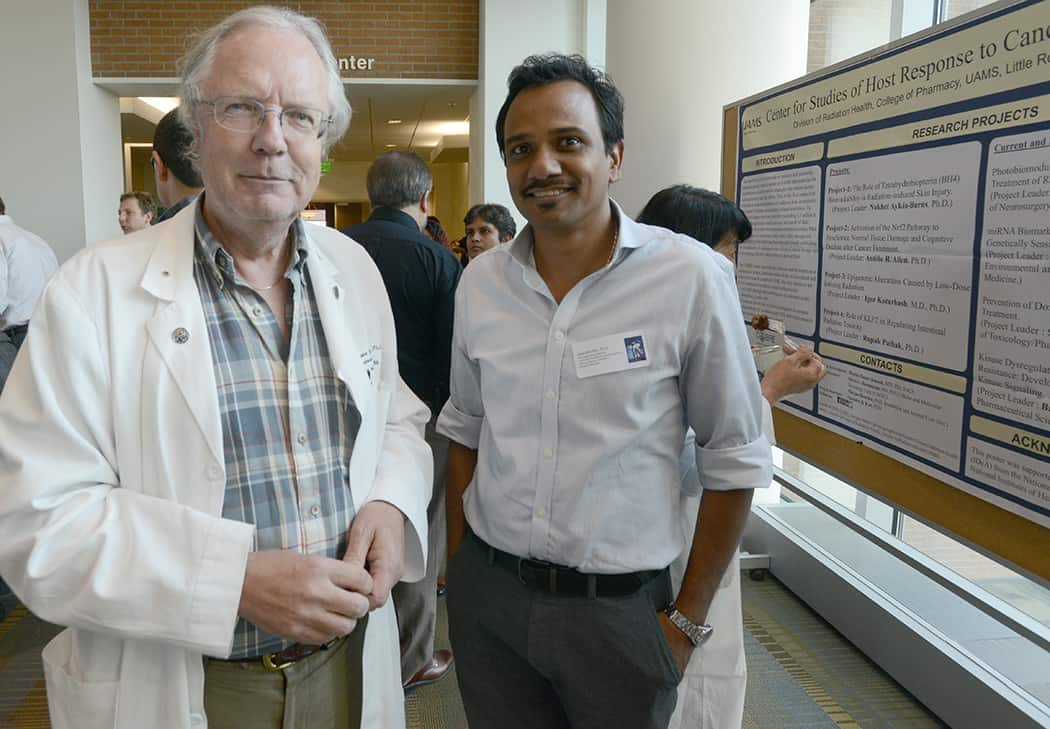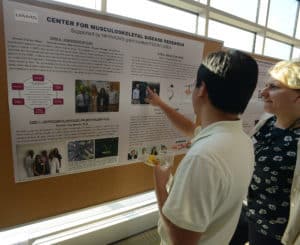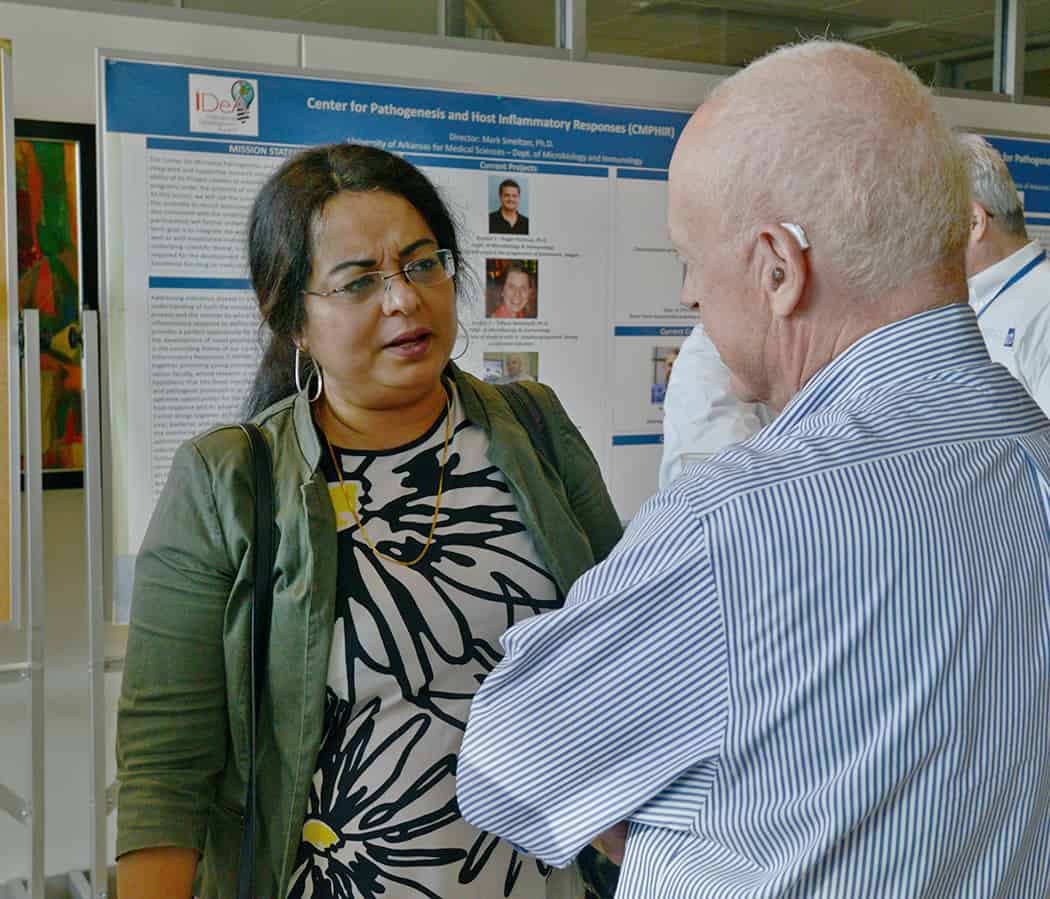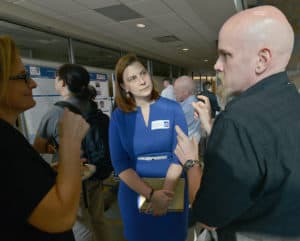Showcase Puts COBREs in Spotlight
| Sept. 27, 2018 | Have the COBRE programs at UAMS and ACRI reached critical mass and can now benefit the entire campus research community?
Mark Smeltzer, Ph.D., certainly thinks so. There are now six active Centers of Biomedical Research Excellence (COBRE) grants from the National Institutes of Health (NIH) at UAMS and the Arkansas Children’s Research Institute (ACRI). That translates to about $11.5 million a year in research funding.
Each COBRE is built around a theme. Junior investigators working on the theme benefit from funding, mentoring, technical support, technology and an environment that encourages collaboration. Participants are more likely to obtain independent federal funding, “graduating” from the COBRE and opening a spot for the next junior researcher to benefit. Over time, an institution develops clusters of expert faculty supported by the necessary technology to be leaders in their field.
But Smeltzer — who is director of one of the more longstanding COBRE programs at UAMS, the Center for Microbial Pathogenesis and Host Inflammatory Responses — thinks the centers can do even more.
“We can integrate the efforts of each program to enhance the overall research infrastructure on our campuses,” Smeltzer said. “We can be better than the sum of our parts, but to realize that potential will require us to be proactive in promoting communication and integration across individual COBRE programs as they grow and develop.”

The Showcase of Medical Discoveries event was held at the Winthrop P. Rockefeller Cancer Institute and attracted one of the largest crowds to date.
As a step in that direction, the COBREs took center stage at the Showcase of Medical Discoveries in September. Organized by the office of Vice Chancellor for Research Lawrence Cornett, Ph.D., and supported by UAMS College of Medicine Dean Christopher T. Westfall, M.D., the showcase is an opportunity for faculty to share their work in a social setting.
Attendees packed into the 10th floor of the Winthrop P. Rockefeller Cancer Institute for one of the most-well-attended showcases to date. They were met with posters and representatives for each COBRE and additional support programs.

The COBRE programs focus on helping junior researchers establish their careers. Each COBRE is organized around a theme.
The COBREs are:
- The Center for Translational Neuroscience; Edgar Garcia-Rill, Ph.D.; $22.5 million; third and final phase.
- The Center for Microbial Pathogenesis and Host Inflammatory Responses; Mark Smeltzer, Ph.D.; $21 million; Phase II.
- The Center for Studies of Host Response to Cancer Therapy; Martin Hauer-Jensen, M.D., Ph.D.; $10.5 million; Phase I.
- The Center for Childhood Obesity Prevention; Judith Weber, Ph.D.; $9.4 million; Phase I.
- The Center for Translational Pediatric Research; Alan Tackett, Ph.D.; $11.5 million; Phase I.
- The Center for Musculoskeletal Disease Research; Charles A. O’Brien, Ph.D.; $11.3 million; Phase I.

Over time, the goal is for institutions to develop pockets of expertise and researchers who have established independent funding.
Each of the COBREs is associated with concentrations of technology known as “cores,” available to researchers whether they are associated with a COBRE or not. These include:
- Flow Cytometry Core
- DNA Sequencing Core
- Irradiation and Animal Core
- Genomics Core
- Experimental Pathology Core
- Tissue Biorepository and Procurement Service
- Brain Imaging Research Center
- Bioanalytical Core
- Digital Microscopy Core
- Ultrasound Imaging Core
- Proteomics Core
- Molecular Imaging Core
- Science Communications Core
- Genetic Models Core
“With the showcase, we hope to provide an opportunity for investigators associated with each program to become better acquainted with investigators associated with other programs and with the technical resources these collective programs have to offer,” Smeltzer said. “We hope this exposure extends beyond the programs themselves to include additional investigators at UAMS and ACRI.”
What’s more, the showcase highlighted efforts to provide resources of interest to all investigators. For example, Mary Aitken, M.D., M.P.H., and the Translational Research Institute are developing a Fundamentals in Research seminar beginning in December that will focus on issues like scientific career advancement, grant writing and management, and leadership skills building. For more information, contact Nia Indelicato at nlindelicato@uams.edu or visit the TRI website.
“The COBRE programs at UAMS and ACRI are having exactly the impact the NIH intends for them to have to build up the environment for quality research and innovative science,” Cornett said. “It is obvious with events like the showcase that the COBREs have created many graduated investigators with independent funding of their own and many collaborative partnerships that never would have taken place. The COBREs have concentrated expertise and technology on our campus in a way that benefits everyone.”

